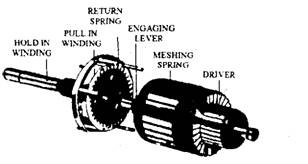15.7.
Permanent-magnet Starter Motor
Permanent magnet starters were introduced on the vehicles in the late 1980s. Less weight and small size are the two advantages of these motors, compared to conventional types. This causes the permanent magnet starter to be more popular as less space is available for engine electrical in modern cars. The reduction in weight also contributes towards reduction in fuel consumption. The standard permanent magnet starters produced are suitable for spark ignition engines up to about 2L capacity and are rated in the capacity of 1 kW or less. Some examples are the Bosch DM range (Fig. 15.23) and the Lucas Models M78R / M80R (Fig. 15.24)

Fig. 15.23. Bosch permanent magnet starter.

Fig. 15.24. Lucas M78R I M80R starter.
The principle of operation is almost similar to the conventional pre-engaged starter motor, in which the field windings and pole shoes are replaced with high quality permanent magnets. This provides a reduction in weight up to 15 percent. The diameter of the yoke can also be reduced by a similar value. Permanent magnets provide constant excitation due to which the
speed and torque characteristic is expected to be constant. However, due to the fall in battery voltage under load and the low resistance of the armature windings, the characteristic is comparable to that of series wound motors. Sometimes flux concentrating pieces or inter-poles are installed between the main magnets (Fig. 15.25). The warping effect of the magnetic field causes the characteristic curve to be very similar to that of the series motor.
Considerable improvement in the construction of the brushes has taken place. A copper and graphite mix is used to make the brushes in two parts, so that higher copper content is in the power zone and higher graphite content is in the commutation zone. This provides an increase in the service life and a reduction in voltage drop, giving higher starter power output.
Permanent magnet motors for a higher power application, have been developed with intermediate transmission of generally epicyclic type (Fig. 15.26). These enable the armatures to rotate at a higher and more efficient speed while delivering the torque, due to the gear reduction. Permanent magnet starters with intermediate transmission are available with power outputs of about 1.7 kW, suitable for spark ignition engines up to about 5 L or compression ignition engines up to about 1.6 L. The principle of operations of this type of permanent magnet motor is again similar to the conventional pre-engaged starter, but can provide a weight saving of up to 40 percent.

Fig. 15.25. Permanent magnet fields with inter-poles.

Fig. 15.26. Starter motor intermediate transmission.
In the epicyclic type intermediate transmission, the sun gear is on the armature shaft and the pinion is driven by the planet carrier. The ring gear or annulus remains stationary acting as an intermediate bearing. This arrangement of gears provides a reduction ratio of about 5:1, which can be calculated by the simple formula;
Reduction Ratio = (A + S)/S
where, A = number of teeth on the annulus
S – number of teeth on the sun gear.
Annulus gears are some time constructed from a high grade polyamide compound with mineral additives to improve strength and wear resistance. The sun and planet gears, however, are made of conventional steel. This combination of materials provides quieter and more efficient operation. Higher output permanent magnet starters are expected to be developed in future for common use.
